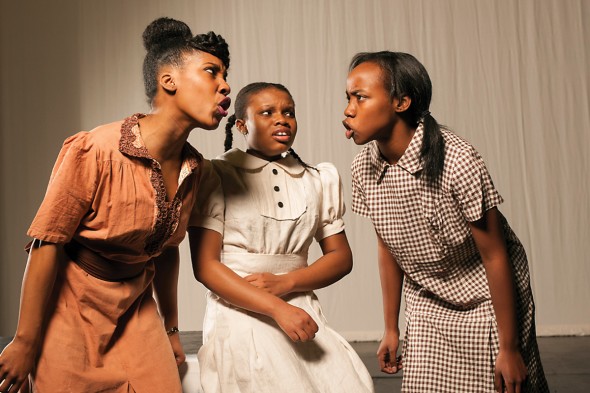UIC Theatre’s ‘Bluest Eye’ looks at race, beauty

Ciera Alexander, Chiagoziem Nwakanma and Jazzlyn Luckett perform in “The Bluest Eye,” which opens Friday. Photo: Michael Brosilow
WHEN
Feb. 22, 23, 28 and March 1 and 2 at 7:30 p.m.; Feb. 24 and March 3 at 2 p.m.; Feb. 27 at noon
WHERE
UIC Theatre, 1044 W. Harrison St.
TICKETS
$16, $11 students with current ID
312-996-2939
“The Bluest Eye,” opening Friday at the UIC Theatre, tells how society’s demands for physical beauty combine with issues of race, class and gender to punish a young girl who is black, poor and — according to her tormentors — ugly.
She dreams that having blue eyes would change everything that’s wrong in her life.
Derrick Sanders has directed the play before. But this time, it’s personal.
“I had a daughter 18 months ago,” said Sanders, assistant professor of theatre.
“I’m interested in the velocity of images coming at young women now. Music videos, reality TV, the internet, all carry so many misconceptions. It’s harder now for young women to have self-esteem, and not just black women.”
Television and computers offer ready means of escapism along with unrealistic standards. Sanders says this play demonstrates that “escapism can be dangerous.”
“The Bluest Eye” is based on the first novel by Toni Morrison, the first African American woman to receive the Pulitzer Prize for literature. It is set in her Ohio hometown during her childhood.
Pecola, the lead character, is obsessed with mass-culture icons like Shirley Temple and the Dick and Jane books. Her mother is equally influenced by Judy Garland, romantic movies and the white family she works for.
Unconsciously, they both accept the affluent white images as a universal standard. They fault themselves for not measuring up and Pecola’s mother projects her self-loathing onto her daughter, with disastrous results.
Sanders calls the The Bluest Eye one of Morrison’s more accessible novels. This stage adaptation, commissioned by the Steppenwolf Theatre Company, “distills the story to its core while being an opportunity for a more abstract visual presentation, a visceral 90 minutes” with no intermission.
The set is abstract, with stark white forms representing the family’s house and other locations. Sanders recruited Daniel Sauter, associate professor of new media arts, to design projections using green-screen technology that will illuminate the set differently moment by moment — for example, adding a black-and-white checkerboard floor or a sandy beach at Lake Erie.
Sanders, a graduate of the University of Pittsburgh, is best known for his work with playwright August Wilson, whose plays chronicled a black neighborhood in Pittsburgh throughout the 20th century. He says “The Bluest Eye” has some commonalities with Wilson’s plays.
“They’re about our culture and deep personal pain in everyday life,” Sanders says. “They ask, what’s your responsibility to yourself? And then, what is society’s responsibility to people?”
